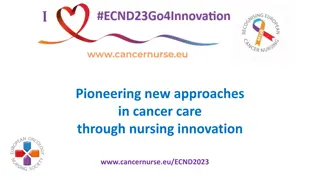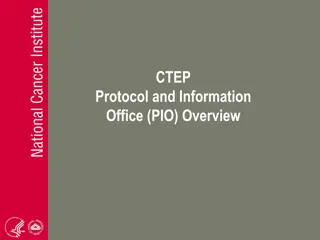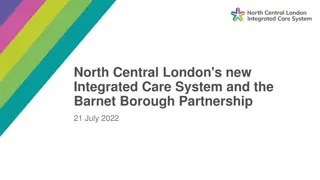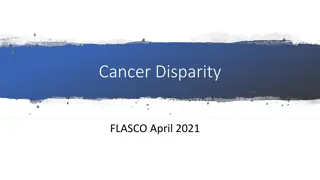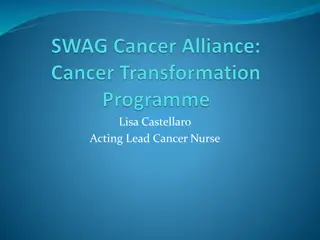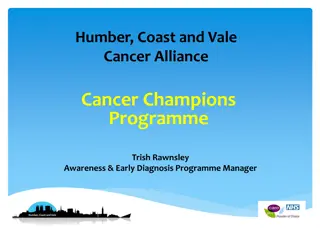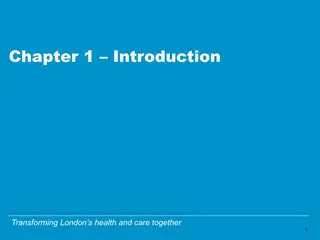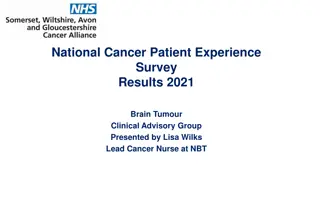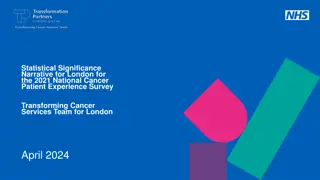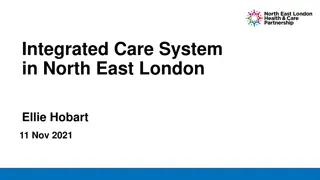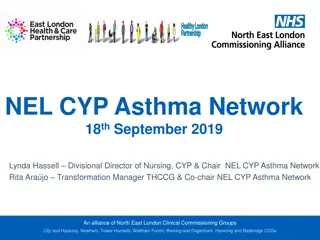Transformation of Cancer Care in North & East London
National cancer vanguard pathway development member, Mr. Dip Mukherjee, leads the initiative to bring together hospital trusts, GPs, health service commissioners, local authorities, and patients across North and East London to revolutionize cancer care. The project focuses on implementing a timed pathway to streamline oesophago-gastric treatment and ensure timely diagnostic and specialist care, adhering to a 62-day rule for cancer communication and treatment.
Download Presentation

Please find below an Image/Link to download the presentation.
The content on the website is provided AS IS for your information and personal use only. It may not be sold, licensed, or shared on other websites without obtaining consent from the author.If you encounter any issues during the download, it is possible that the publisher has removed the file from their server.
You are allowed to download the files provided on this website for personal or commercial use, subject to the condition that they are used lawfully. All files are the property of their respective owners.
The content on the website is provided AS IS for your information and personal use only. It may not be sold, licensed, or shared on other websites without obtaining consent from the author.
E N D
Presentation Transcript
Implementing a Implementing a timed oesophago oesophago- -gastric gastric p pathway timed athway Mr Dip Mukherjee OG Surgeon National cancer vanguard pathway development member Pathway director NCELA Bringing together hospital trusts, GPs, health service commissioners, local authorities and patients across north and east London to transform cancer care
WHY ? WHY ? Bringing together hospital trusts, GPs, health service commissioners, local authorities and patients across north and east London to transform cancer care
The old world Bringing together hospital trusts, GPs, health service commissioners, local authorities and patients across north and east London to transform cancer care
The old world Bringing together hospital trusts, GPs, health service commissioners, local authorities and patients across north and east London to transform cancer care
What ? What ? Bringing together hospital trusts, GPs, health service commissioners, local authorities and patients across north and east London to transform cancer care
Bringing together hospital trusts, GPs, health service commissioners, local authorities and patients across north and east London to transform cancer care
Bringing together hospital trusts, GPs, health service commissioners, local authorities and patients across north and east London to transform cancer care
62 day Rule Rules 28 Day FDS All cancers April 2020 Whole system Diagnostic only All providers Patient communication is the endpoint at 28 days OG Timed pathway OG cancer only April 2020 OG cancer only Diagnostic specialist staging and treatment Diagnostic and specialist MDTs Endpoint in 42 days similar to 52 days Bringing together hospital trusts, GPs, health service commissioners, local authorities and patients across north and east London to transform cancer care
Bringing together hospital trusts, GPs, health service commissioners, local authorities and patients across north and east London to transform cancer care
National Timed Pathway Bringing together hospital trusts, GPs, health service commissioners, local authorities and patients across north and east London to transform cancer care
How? How? Bringing together hospital trusts, GPs, health service commissioners, local authorities and patients across north and east London to transform cancer care
Outline Form a small coalition Measure the current state of play Rapid improvement by marginal gains Influence rather than line manage Recognise differences Encourage innovation: Process, Resource & Workforce Project management approach crucial Bringing together hospital trusts, GPs, health service commissioners, local authorities and patients across north and east London to transform cancer care
The process Soft conversations through existing fora Gap analysis Engagement event and workshop to develop solutions Implementation group and an alliance level project Executive sign off of plans: COO / Trust CEO/Alliance board STP Shared learning during delivery service development innovation workforce Bringing together hospital trusts, GPs, health service commissioners, local authorities and patients across north and east London to transform cancer care
Aims of the project Improve the streamlining of the transfer between local units and specialist centres. Improve patient experience on the diagnostic pathway. Improve outcomes for patients with OG cancer. Reduce variation in OG services and outcomes across the NCEL network. Prepare systems for the introduction of the FDS.
Role of the Cancer Alliance To provide clinical leadership and project management support. Facilitate cross-trust working, sharing best practice and learning in NCEL trusts. Support trusts to develop and implement their action plans for OG diagnostics pathway. Develop and maintain project management documentation and monitor progress against the national metrics (OP11). Provide project support, when appropriate, for system- wide changes. Support stakeholder engagement across the network.
5 pathway steps to deliver The 5 pathway steps are defined as follows: 1. There will be organisational agreement to implement the oesophago-gastric pathway by 31st March 2020, with key clinical and operational leaders engaged in the implementation planning process. 2. Roles and responsibilities of local and specialist teams in the diagnostic and treatment pathway will be specified. 3. All appropriate organisations delivering the oesophago-gastric pathway will have clinically-led triage in place to facilitate streamlined access to initial diagnostic tests, which will include straight to test OGD (STT) for eligible patients and a subsequent CT scan if required. There will also be a clear, standardised pathway for those patients who are unfit for STT. 4. All appropriate organisations delivering the oesophago-gastric pathway will have standardised protocols and templates in place to ensure streamlined referral both to and from the sMDT. 5. All appropriate organisations delivering the oesophago-gastric pathway will have clear clinical guidance for further staging investigations to inform and support agreement of treatment options. https://www.england.nhs.uk/wp-content/uploads/2018/04/implementing-a-timed-oesophago-gastric- cancer-pathway.pdf
What did we do ? Socialising FDS and timed pathway conversations Gap analysis Engagement event Project Initiation Document Implementation group formation :13 NHS Trusts Sharing learning & Innovation Continuous measurement
January 2019 January 2019- -June 2019 June 2019 First six months of the year focussed on preparation for implementation. Gap analysis of current OG services and audit of patients entering the urgent 2ww pathway. Identified complex issues in the pathway, from referral to definitive diagnosis, which will impact on delivery. Highlighted priority areas for improvement. Showed that approximately 41% of patients on an urgent OG cancer pathway were given a diagnosis of cancer/non-cancer within 28 days of referral. Pathway launch event (June 2019). To ensure that everyone involved with the OG pathway understands the expectations and where they need to focus their resources. Findings of audit presented back to trusts. Facilitated workshops aimed at identifying issues in the pathway and possible solutions. Outputs formed the basis of trust specific implementation plans.
Preliminary data from oesophago-gastric pathway audit Oesophago-gastric national timed pathway event 4th June 2019
Background and methodology The National Oesophago-Gastric (OG)Timed Pathway was released in April 2019, with a date for implementation of April 2020. Trusts in NCEL were asked to undertake a 10 patient audit in order to determine current compliance with the pathway, where bottlenecks occur and highlight issues where the Cancer Alliance can support improvement. An audit template was created, based on the steps and timings of the national timed pathway, with an additional page of questions requiring a narrative response. Each trust was requested to complete the audit for the first 10 OG referrals received in January 2019 and the templates were returned to the Cancer Collaborative for analysis. The data presented can be used to inform the next steps of pathway implementation for individual trusts and also across North Central and East London, where economies of scale may make it more feasible to link as a network.
Data available for analysis The data presented is for 90 patients from 9 sites, as follows: Barking, Havering and Redbridge University Hospitals (BHRUT) Barnet and Chase Farm (BCF) Homerton University Hospital (HUH) North Middlesex University Hospital (NMUH) Royal Free Hospital (RFH) Royal London Hospital (RLH) University College London Hospitals (UCLH) Whittington Health (WH) Although, not within the area of North Central and East London, data from Princess Alexandra Hospital (PAH) has been included as referrals are made from PAH into the specialist centres. 10 patients per site is small sample size and where there has been insufficient data to analyse, this has been noted.
Pathway overview referrals (reported by trusts) OG 2ww referrals received by hospitals in Q3 (Oct - Dec 2018) 2018/19. NMUH referrals received are for both OG and HPB; BCF and RFH are just OG. N.B. WH and HUH are omitted as the number of referrals received was not recorded in the audit. 400 350 300 Number of referrals received 250 200 150 100 50 0 BHRUT BCF HUH NMUH PAH RFH RLH UCLH WH Hospital
Overview of pathway diagnostic timeline (median) 35 30 25 Days on pathway 20 STT/DA pathway No STT/DA 15 National timed pathway 10 Day 28 5 0 Referral Triage/OPA Endoscopy CT Histology received Patient informed of diagnosis Step on pathway The median days to CT scan may be longer than that to histology report as currently CT scans are not performed within 24 hours of endoscopy. It is not clear at what point CT scans are booked. As only two patients were discussed at MDT, one had staging tests and one was referred to a specialist centre, these data points have been removed.
Referral to diagnosis times BHRUT UCLH NMUH PAH Trust Homerton RFH Royal London Whittington 0 7 14 21 28 35 42 49 56 63 70 77 84 Number of Days 91 98 105 112 119 126 133 140 147 154 161 168 175 182 The shortest time to a patient being informed of a cancer/no cancer diagnosis was 4 days (WH) and the longest recorded was 180 days (BHRUT). However, this and two other patients at BHRUT have future dates recorded as the date a diagnosis was given. The median for all trusts, with the exception of Whittington Health, was greater than 28 days. The 10 Whittington Health patients were all informed that they did not have a likely diagnosis of cancer at the time of endoscopy and, therefore, within 14 days of referral. The data is not included for BCF as the date the patients were informed of their diagnosis was not recorded in the audit, although the outcome was.
Direct access to endoscopy and STT pathways Hospital Does your Trust have a pathway for direct access endoscopy for OG? Does your Trust currently have a straight-to-test pathway for OG referrals (i.e. referral is triaged and patient is booked straight into a diagnostic test)? If yes, approximately what percentage of patients go through the straight-to-test pathway? BHRUT No Yes 10% BCF Yes (but not for all CCGs) Yes 50% HUH Yes No N/A NMUH No No N/A PAH Yes Yes 64% RFH No No N/A RLH Yes Yes 40% UCLH Yes Yes 90% WH Yes Yes >90%
Straight to test pathways Hospital Who, within your hospital is responsible for triaging patients onto the straight- to-test pathway? Does your hospital follow specific protocols for triaging patients onto the STT pathway? Is choose and book available for the straight- to-test pathway? If so, how does this work? BHRUT Gastroenterologists/ Clinical Nurse Specialist No No BCF All 8 Gastroenterology Consultants Yes All appointments are booked via ERS into a 'triage clinic' and triaged either STT or an OPA by the consultant. HUH N/A N/A N/A NMUH MDC pathway has dedicated CNS and Consultant Yes - on MDC pathway No PAH Gastroenterology Consultant No specific protocol - Gastroenterologist makes a clinical review based on the information available. No RFH N/A N/A N/A RLH Gastroenterologists Yes Yes - for non cancer patients UCLH Nurse Endoscopist Yes Yes - via a referral assessment service WH Gastroenterology consultants Yes Yes - GPs book patients straight into an endoscopy slot. These are triaged daily to ensure that STT endoscopy is appropriate.
Times from referral to endoscopy BHRUT UCLH NMUH PAH Trust Homerton RFH BCF Royal London Whittington 0 2 4 6 8 10 12 14 16 18 20 22 24 26 28 30 32 34 36 38 40 42 44 46 48 50 52 54 56 58 60 62 64 66 68 Number of Days Of the 90 patients referred, 90% (81) had an endoscopy. 25% of these were performed within 7 days of referral and 57% within 14 days. The shortest time from referral to endoscopy was 2 days and the longest was 64. The audit showed a variation in the speed of access to endoscopy between the hospitals with a DA and/or STT pathway and those without. None of the patients referred to trusts without DA pathway had an endoscopy within 7 days, and only 1 patient referred to a trust without an STT pathway had an endoscopy in this time (HUH). 1 of 20 patients referred to trusts with either DA or STT pathways had an endoscopy within 7 days while 38% (19 of 50) for those with both had an endoscopy within 7 days.
Constraints to provision of DA or STT Hospital If no, what are the main constraints within the trust to providing a pathway for direct access endoscopy? What are the main constraints to your trust in implementing a straight-to-test pathway for all suitable OG 2ww referrals? BHRUT 1. Endoscopy capacity 1. Endoscopy capacity 2. CNS support BCF Not answered 1. Endoscopy capacity HUH N/A 1. Endoscopy capacity 2. Workforce capacity i. ii. inability to include additional endoscopy lists. insufficient cover for sickness and annual leave. NMUH 1. Endoscopy Capacity 2. Ability to assess suitability of diagnostic based on GP referral 1. Endoscopy Capacity 2. Ability to assess need based on GP referral 3. Current ERS system direct to 1st outpatient appointment PAH N/A N/A RFH 1. Endoscopy capacity 2. CNS capacity and support 1. Endoscopy capacity 2. CNS capacity and support RLH Not answered 1. Variability of referrals. 2. Currently no STT for 2WW colonoscopies. 3. Weight loss referrals very difficult to deal with outside a clinic environment. 4. HPB referrals come through the same pathway. UCLH 1. Not applicable 1. Dedicated administrative support WH 1. Endoscopy capacity - currently insourcing to meet capacity and targets 1. Endoscopy capacity
The national timed pathway requires patients to have a CT scan within 7 days of referral and 24 hours of endoscopy, if a suspicious lesion is seen. Not CT scans all patients, therefore, will need a CT scan. Of the 81 patients who had an endoscopy, 27% (22) went on to have a CT scan. The shortest time from endoscopy to CT was 3 days (BHRUT) and the longest 54 days (RLH). 5 patients had an OPA followed by a CT and no endoscopy. These patients waited between 8 and 23 days for a CT scan following an OPA and from referral waited between 23 and 66 days for their first diagnostic test. NMUH has an informal agreement to book same/next day CTs from endoscopy, HUH can do this between Monday and Friday for limited slots (under review) and PAH is currently reviewing this as the trust now has an additional scanner. The remaining trusts do not have capabilities to book a same/next day CT scan at endoscopy.
Histology biopsy to reporting Biopsies were taken for 41 of the 81 patients who had an endoscopy (51%), or 46% of all 90 patients. (a proxy measure was used to obtain the number of biopsies, i.e. date histology reported) Histology reports were available for 25% of biopsies within 3 days, but there was a marked variation, even within trusts, which needs further investigation. N.B. NMUH = when report available; RFH = day report received. 18 16 14 12 10 Days 8 6 4 2 0 BHRUT BCF HUH NMUH PAH RFH RLH UCLH WH Hospital Median (all trusts) Median endoscopy to histology report National timed pathway target
Waiting times for a diagnosis 28 patients who had a biopsy also had a recorded date that they were given a definitive diagnosis of cancer/non-cancer. 3 of these were informed at the time of their endoscopy that they did not have cancer, before the histology results were available. Of the remaining 25, the range of days between histology reporting and patients being given a definitive diagnosis was 3 108 days, with a median of 17 days. 63 patients who had an endoscopy also had a recorded date that they were given a definitive diagnosis of cancer/non-cancer. The range of days between endoscopy and patients being given a definitive diagnosis was 4 180 days, with a median of 30 days. 2 of these patients had a cancer diagnosis. The remainder were not given a cancer diagnosis.
Of the 90 patients audited, two were presumed to have a cancer diagnosis based on one having staging tests and one being referred to a specialist centre.. Outcomes for patients not diagnosed with cancer 88 patients were not diagnosed with cancer. A quarter of these were discharged back to their GP and did not need follow-upon and one fifth were discharged with recommended next steps. 11% (n=10) were required to have further diagnostic tests, while 6% (n=5), were referred on to another consultant. Discharged - back to GP with recommended next steps Discharged - back to the GP with no follow-up Further diagnostic tests 20% 24% Onward referral to another consultant Other 13% Not stated 26% 6% 11%
Constraints to delivery of the 28 day FDS Hospital Percentage currently meeting 28 day standard, if audited What are the main issues within your trust with meeting the 28 day faster diagnosis standard for the OG pathway? BHRUT UGI baseline in April 15.8% UGI May position is 39.7% 1. Gastroenterologist vacancies 2. CNS and Cancer Referral Office capacity/workload BCF Q4 (Jan - Mar 19): 40% ; Q1 (Apr - May 19): 53.33% 1. Capacity (endoscopy & radiology) HUH Q4 18/19 69% for all Upper GI Not answered NMUH Audit conducted July 18 identified significant delays in patients not referred via the 2ww pathway and other delays associated with multi hospital involvement 1. Diagnostic capacity 2. Workforce capacity PAH 64% 1. Consultants reviewing diagnostic testing 2. Creating clinic letters to be sent to patients and GPs informing them of outcomes - consultant and typist time. RFH Q4 (Jan - Mar 19): 35.34% Q1 (Apr - May 19): 37.29% 1. Patient attendance. 2. Lack of information given to patients at time of referral. 3. Inappropriate referrals from GP's not meeting 2ww criteria overwhelming the system. RLH Not audited 1. Histopathology currently 50% vacancy. 2. Access to dedicated radiology slots. 3. Patient choice. 4. The way in which the 2WW patients are followed up means that with annual leave and on-call commitments capacity varies through the year. UCLH Not audited 1. Imaging capacity 2. Outpatient capacity for follow up 3. Discharge process 4. Inter MDT referrals WH Currently auditing 1. Imaging 2. Out-patient clinic availability
The point at which diagnostic tests were completed varied by hospital, depending upon whether DA or STT pathway was available. Where a hospital had a DA and/or Summary a STT pathway, patients were usually given an endoscopy sooner. Trusts without a DA and/or STT pathway always waited longer than 7 days for an endoscopy. The range of times from referral to diagnosis at these trusts was 15 133, with medians of 74 (RFH) and 31.5 (NMUH). Not all patients needed a CT following endoscopy (36% had a CT). There is no formal provision to book same/next day scans, which led to delays in imaging with patients waiting between 4 and 32 days for a CT after endoscopy. 48 of the 50 patients were given a non-cancer diagnosis. 50% of these were referred back to their GP. Where a date of diagnosis was recorded, 56% of patients were given their diagnosis of cancer/non-cancer within 28 days. All of the WH patients audited were given a diagnosis of likely cancer/non-cancer at their endoscopy appointment. Endoscopy capacity was reported as the main constraint to delivery of both the DA and STT pathways and the 28 day FDS, although imaging capacity is also an issue for the delivery of the FDS along with outpatient clinic availability.
Use audit findings for whole of NCEL to inform discussions in workshops at the OG timed pathway event in June. Recommendations Invite Whittington Health to share feedback on their practice which seems to be already informing patients that they do not have cancer within 14 days of referral. Consider the practice of telling patients they do not have cancer at endoscopy appointment who is qualified to do this, how is this done and recorded. Prioritise review of endoscopy capacity and STT and DA pathways. Review CT booking processes inability to book a CT within 24 hours of endoscopy could be a rate limiting step to confirming a cancer diagnosis. Look into variation in histology reporting. Work with primary care to develop a minimum dataset for referral and improve referrals on a 2ww pathway. NMUH look at possibility of reconfiguring ERS to enable booking directly into an endoscopy slot following triage. Continue to work with trusts and patient groups to develop pathway specific information to improve patient compliance.
Engagement event Introduction to the timed pathway including FDS definition Mr Dip Mukherjee, Consultant Upper GI Surgeon, BHRUT and OG Pathway Board Director and Andy McMeeking, Deputy Director Improvement, Transforming Cancer Services Team for London. Oesophago-gastric national timed pathway audit findings Caroline Cook, Senior Project Manager, NCELCA. Lessons learned from previous national pathway implementations Liz Rippon, Cancer Chief of Operations, UCLH.
Workshop output Key points arising from this session were: There is variation in availability of direct access (DA) and straight to test (STT) pathways between trusts, which can impact time to endoscopy. The quality and completeness of information provided on referral forms varies and sometimes multiple referrals are made on different pathways. The quality of clinical assessment during endoscopy varies depending on the experience of the endoscopist. There are long waits for CT scans in all trusts. Commonly, this was due to relevant blood tests not being done at referral. Turnaround times for pathology are slow but variable between trusts biopsies from endoscopy are not always treated as urgent and electronic request forms make it harder to flag urgent specimens. Lack of agreed processes means that delays occur when samples are transferred between labs and reports are sent to clinical teams, not MDT coordinators, leading to delays in adding patients to the MDT list. Data capture is impacted by workforce capacity, for example, lack of leave cover for triage and PTL tracking. Data entry to the CIS is also manual and some processes are unclear.
Workshop output Information received from GP varies even with a minimum data set and blood tests are not always done at referral. This can be improved with support from GPs and CCGs/STPs. Two week wait referrals are not always reviewed by the most appropriate decision maker at the start of the pathway which has implications for the rest of the pathway. Staffing levels do not provide operational resilience as there is insufficient leave cover for administration, triage, CNS and endoscopy staff. Capacity in outpatients in particular does not always prioritise the urgent patients and needs review. In one trust, there are processes in place to prioritise urgent samples on some pathways, but not GI. If OG cancer is suspected, processes should be in place to make sure samples are flagged as urgent at endoscopy. Processing of samples in external labs may not always be necessary if there is capacity to do these in house with less delay. It is not always clear from the endoscopy report whether or not patients are still on a cancer pathway following endoscopy as the information given can vary by endoscopist. Compulsory outcome boxes on the reporting template would reduce occurrences of this. Waiting times to CT scans is variable and delays occur for differing reasons, but could be improved with a set of standardised mandatory blood tests being done by the GP at referral.
Start of the pathway (direct access/ triage /STT) Start of the pathway (direct access/ triage /STT) facilitated by Naser Naser Turabi Turabi facilitated by What skills are required for a triage role could this be a registrar or a CNS? Administrative flows can become complicated. Possible solutions Cerner/other EHRS tool can make redirection of patients easier. Business case for FDS triage nurse to telephone all patients, has helped the endoscopy DNA rate at BCF. Carve out slots. Learn from the colorectal pathway. MDC future plans Broaden to all Upper GI Non-clinical/clinical admin/coordinator role is very important. Issue with people who are found to no longer be 2ww RLH has both pathways. PAH referrals are fast tracked to endoscopy (gastro) UGI triage/vetting. OPA given if complicated Otherwise STT Endoscopy patients are phoned by bookers with a script and followed up by letter. Support given by consultant of the week (M-F) Gastroscopy usually within 10 days. ? RAS Potential issues raised: Sometimes there is disparity between the GP referral form and what the patient says. Limited contextual information on the form, apart from test results. Multiple referrals made on different pathways. WH triage STT rota requires blood test results from primary care.
Diagnostic tests (endoscopy, CT and other tests) Diagnostic tests (endoscopy, CT and other tests) facilitated by Caroline Cook Caroline Cook The role of the CNS was noted to be key from the start of the pathway for liaising with GPs, confirming patients understanding and communicating the need to comply with the pathway. Issues raised: Endoscopy waiting times need to be reduced to 7 days. CT scans can have long waiting times and are not booked by the same department as endoscopies. Delay to CT scan appointments is often because the relevant blood tests have not been done. The quality of clinical assessment during an endoscopy, including photos taken for MDT discussion, varies with experience of the endoscopist. Possible solutions: CTs - a standardised set of blood tests could form part of referral (currently being developed for MDCs). Patients could be phoned to make an appointment for speed and convenience. The potential need for a CT scan can be assessed at referral and the appointment for a scan can be made at that point. Allocate designated CT slots which can be booked at endoscopy and are linked to clinic and endoscopy slots. There was a query about who would be responsible for booking these as CTs and endoscopies are booked and performed by different departments. facilitated by
Pathology Pathology facilitated by Holly Norman facilitated by Holly Norman Turnaround time (TAT) Biopsy if obviously a cancer the sample is marked (PAH) to identify it as urgent. Biopsy urgently taken to histology lab and fast tracked (or couriered). Clear marking of CWT samples Not always known that someone is on a cancer pathway. Move to e-forms is making flagging samples harder and less obvious. Travel time HER2 transfers from PAH to UCLH can take a week small percentages. PAH have agreed a protocol where younger patients are routinely tested for HER2 (avoiding individual requests). These are sent by pathology. Transfer between labs (e.g. for specialist opinion). There are no arrangements to smooth this process (a tracker/coordinator helps with this). Reporting is to the clinical team and there can be delays getting to MDT. PAH have a flagging system so cancers are always communicated quickly (via MDT coordinators) and pathologists can put people on the MDT list. Tracking of samples - communication is challenging. Hard to track. BHRUT get a list of priorities for lung, breast and prostate, but not OG. PAH have coordinator/tracking roles. Pathology is hard to understand poor visibility on why things re taking too long. Outsourced endoscopy raised queries: How quickly do they reach the labs? Who looks at the slides? not clear to trusts. What happens to the false negatives? Resources in labs
Communication with patients (how to communicate a non Communication with patients (how to communicate a non- -cancer diagnosis face/letter/phone face/letter/phone - - and direction to appropriate next steps) and direction to appropriate next steps) facilitated by Helen Saunders and Dave Pritchard Saunders and Dave Pritchard The CNS should meet patients early, e.g. at endoscopy, and also to support next steps. Issues raised: Content of endoscopy report varies depending on endoscopist. Phone after MDT this can be problematic. Information sheet needs to emphasise possible rule out of cancer. More to do with awareness from GP. Delays in diagnostic reviews may delay communications with patients. What information is given after a suspicious endoscopy? Possible solutions: At PAH a letter is sent after endoscopy to confirm a non-cancer diagnosis. This is a template letter, including next steps and the process is agreed by the CCG. Barnet continuity of CNS input from triage Barnet standard leaflet being signed off Barnet letter sent same day (set up for lung) UGI going digital in the autumn CPG team Diagnostic reviews need to be daily and in job plans. Can try having an allocated time at the end of each list to review. Wording I have informed the patient . Should also discuss with patient s escort. cancer diagnosis- - face to facilitated by Helen face to
Communication with primary care (referral and discharge) Communication with primary care (referral and discharge) facilitated by Andy facilitated by Andy McMeeking McMeeking and Sophie Morris and Sophie Morris Referrals Challenges include: ERS triage slots and manual workarounds Confusion for patients/ sometimes angry patients GPs not aware of issue ?EMIS workaround GP comms required Referral information for triage is not always complete (free text) GP confidence in upper GI to lower GI referral. Possible solutions: Ensuring right referral information is included such as bloods - feedback to CCGs and GPs name and shame.
Communication with primary care (referral and discharge) Communication with primary care (referral and discharge) facilitated by Andy facilitated by Andy McMeeking McMeeking and Sophie Morris Discharge Copy of OGD report at point of assessment/diagnostics same day discharge. OGD report not inclusive of discharge and reasons why clarity of PTL record. Back up duplication of GP discharge letter reflecting OGD report. Possible solutions Protocolisation of discharge requirements. Constraints on fields to provide clarity of discharge - i.e. endoscopy report cannot be completed until the discharge to GP is defined. OGD result, drumming down consultant practice of taking off at source not all consultants remove patients from the pathway following a negative endoscopy. Cumulative information capture from referral to discharge to streamline information to GP at discharge. PAH model - tick box story board of what has been done and next steps given to patient and copied to GP. Also, free text for specific actions for discharge without cancer. MDT coordinator has access to all systems. and Sophie Morris
Data capture Data capture facilitated by Donna Chung facilitated by Donna Chung and and Emma MacArthur Emma MacArthur People MDT coordinators historically focus on cancer patients, not non-cancer patients Have the right people got access to Cancer Information System (CIS) (Somerset/InfoFlex) to enter elements of FDS Leave cover for clinical triage and PTL, both at receipt of referral and for day 28. Manpower Data entry into CIS is a manual processes from the tracking list. Uncertainty about the procedure i.e. who communicates the discharge, enters the data and how the patient is informed of discharge. Needs a tracker to get the PTL going.
Data capture Data capture facilitated by Donna facilitated by Donna Chung and Emma MacArthur Chung and Emma MacArthur Letters Who is producing/sending/recording these in patient records? Is it the patient navigator or clinicians? Process Clinical triage of referral PTL reviewed mostly weekly. Should it be reviewed daily? Multiple systems There are multiple systems which need to be integrated with workflow. EHRS Unisoft/endoscopy. Appointments Results (bloods/path) CIS
June July 2019 Patient information leaflet Developed with patient representatives, clinicians, managers, CNSs. Clearly sets out the pathway so patients know what to expect. Will improve patient engagement with the pathway. Added to ERS systems to be provided by GP at point of referral. Implementation Group Group established to share learning and best practice across NCEL trusts and provide support. Membership clinical and managerial leads for the trusts, alliance project clinical lead and project manager. Teleconference reduces impact on clinician time.
Project documentation Development of project initiation document (PID). Detailed document setting out reason for change, benefits and aims, metrics, scope. Includes stakeholder engagement and communications plan. Live document, which is updated as the project evolves. Provides a focus for the project team. Gantt chart To plan milestones and tasks and to track the progress of the project. Risk and issues log Managed by the project manager and reviewed by the implementation group.
Key milestones Milestone Lead Estimated target date 31st May 2019 1 Gap analysis of current performance against the pathway completed Caroline Cook 4th June 2019 2 Pathway event for trusts across NCEL held Dip Mukherjee/ Caroline Cook 30th June 2019 3 Gap analysis on implementation of the 5 pathway steps performed by trusts Updated gap analysis data shared with trusts All trusts in NCEL 19th July 2019 4 Caroline Cook 31st July 2019 5 Project implementation steering group established Dip Mukherjee/ Caroline Cook 30th September 2019 6 Trajectory and plan to implement the 5 pathway steps developed by trusts and agreed by STPs Trust clinical and operational leads 30th September 2019 7 Implementation group work plan developed Implementation group 31st March 2020 8 Five pathway steps implemented by trusts All trusts



